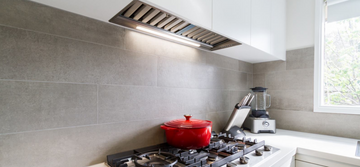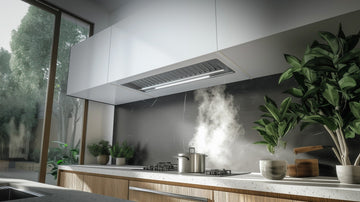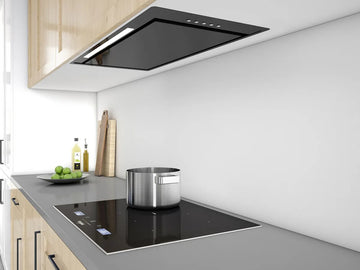Let's Talk Sound
Our Sirius rangehoods are designed for maximum performance at minimum sound. We’ve taken into account every type of cooking style when designing our range with powerful airflow rates from 600m3/h to a substantial 2800m3/h as well as 350m3/h for your bathroom extractor.
Just like with any appliance, installation and the surrounding materials can affect the sound your rangehood produces, which makes it hard to provide an accurate decibel dBA (or dB) rating.

First, let’s touch on the difference between dB and dBA; dB is the ‘raw’ measure of sound, where dBA takes human perception into account. dBA accounts for the human ears natural filter, giving a more realistic idea of sound.
Whenever a dBA reading of one of our rangehoods is taken by our manufacturer, it’s taken at a simplistic level, not taking into account how a product is installed in your kitchen, the surrounding materials, or the type of motor and ducting is used. These additional factors play a critical role in the actual noise level you may experience in your kitchen while using your rangehood.
Surrounding Material
There are so many things to take into consideration when placing your rangehood. Like with everything, the hood reflects off the surrounding surfaces, which can amplify the noise level. This would be of particular notice if you had, for example, a metal splashback where sound is more likely to echo.

Installing your rangehood surrounded by or in your kitchen cabinet can both reduce and amplify the sound, depending on the cabinet material. Wood is generally known to help absorb sound and reverberations, while laminate or veneer finishes have a harder surface which sound can bounce off. And if you enclose your ducting and unit within the cabinet, this can cause a ‘drum’ effect, amplifying sound as it bounces off the surfaces.

Rangehood Placement
Ensuring your rangehood is properly placed; 600-750mm above the cooking surface and covering the cooktop adequately ensures proper ventilation which also affects the noise level. If not placed in this prime position, the rangehood may have to work harder to perform, which increases the noise level.

Motor & Ducting
Offboard Motors: Using an external motor means the rangehood engine is placed away from the cooking area which is another way to reduce the noise level; it’s easier for the motor to pull the air rather than push it out. However, ensuring you place the motor at the right distance is important as you can still get ambient noise if it’s too close. Between 2 to 5 meters away from the hood is the ideal motor placement and with the proper airflow and duct work, you’re on track for a quiet rangehood.
Always be mindful of where you place your motor and this can affect your outdoor living space, or your neighbours.
Onboard Motors: The motor is built into the unit, so it’s in the kitchen area. Due to this proximity, and the motor pushing air out, which is harder than pulling, this type or rangehood can typically be a little noisier during use. Our revolutionary technology paired with advanced engineering has allowed us to create Green Energy Motors, offering exceptional power, airflow and noise reduction, while operating at optimum levels without the additional power costs.

Sharp bends create resistance in the airflow. The more bends, twists and turns or excessively long runs your ducting has, the harder the motor needs to work, the louder the rangehood will be. But it also shouldn’t be straight. Think of the ducting as like a bottle, if you blow across the top of the bottle, you get a whistling sound. This is the same as the wind blowing across the vent and down the ducting. By add a couple of 450 angles this with reduce any whistling you may get from the vent and making it as direct as possible from the hood to the vent, you’ll get the best for your rangehood.
Using the right duct size if essential. If you try and adapt existing ducting that doesn’t fit your new system, this will affect how the motor works, which in turn affects how the rangehood performs. For example, if you adapt your existing 200mm ducting to try and fit a 150mm size hood, this can increase the sound by 40%.

If your ducting is compressed, has holes or been nibbled on by rodents, or if there’s anything stuck inside it along the run, will affect the sound.
How you secure your motor will also affect both the operation and the noise level of your rangehood. Ensuring all parts are securely mounted will reduce the vibrations created during operation. Movement creates sound; less vibration, less noise.
If you want a motor with more power, why not try one of our twin motor options. Double the motor doesn’t mean twice the noise, in fact together the motors provide the same energy, with less movement, which means less noise.
Use
How you use your rangehood can affect the noise level it makes. The higher the fan speed, the harder the motor needs to work, which produces more noise. If you’re running your hood on a fan speed of 4 every time you use it, then it isn’t the right rangehood for you. Our Sirius rangehoods are powerful enough that you’ll only need to use Level 4 as a booster.

For everyday cooking, you should only require a fan speed of 1, the quietest level. Level 4 is more of a booster option, for when you’ve burnt something and need to clear the air quickly. It also helps to turn the hood on at least 5 minutes before you start cooking, this will keep the air clearer and reduces the need for higher speed and power, creating more air movement with less fan movement.
Other Factors
Other factors to consider, especially if your rangehood has become noisy over time include loose parts; a screw may have come loose or a filter not put back in properly or a butterfly valve may be loose; or the filter may need cleaning as it’s clogged with grease buildup, or you may need to replace a carbon filter. Open windows or doors can actually work against the rangehood pulling the air currents in opposite directions, in turn making the hood work harder.

Another factor to consider is that you just may not have the right rangehood setup that works best for your space. Ensuring your rangehood produces the right amount of power for the space it’s in and your general style of cooking will help find the right solution for you. Check out our Air Movement Calculator to find your ideal hood.

So, you can see that providing an accurate dBA reading is incredibly difficult, in fact it’s impossible to provide anyone with a precise reading of what they’re going to experience in their home. This is why we provide an estimated decibel range, which we take during testing in the factory, which gives you a good idea of what to expect of your rangehood’s performance.
And ensuring your rangehood is installed in the optimal position, with the ideal ducting and motor configuration and knowing how best to use your hood will certify your rangehood is working it’s best at its quietest noise level. For this, we highly recommend investing in a qualified installer.



